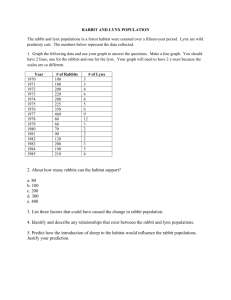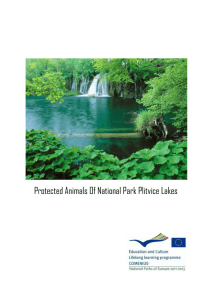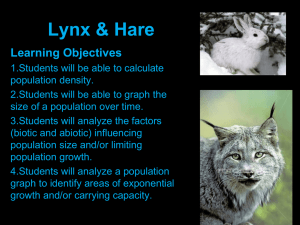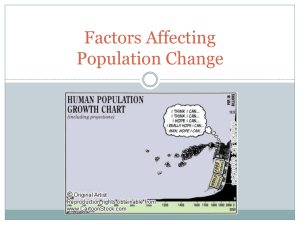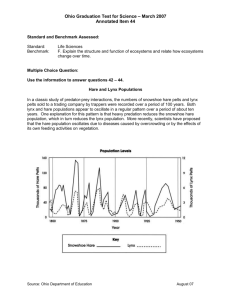The Scientific Basis for Lynx Conservation: Qualified Insights Chapter 16
advertisement
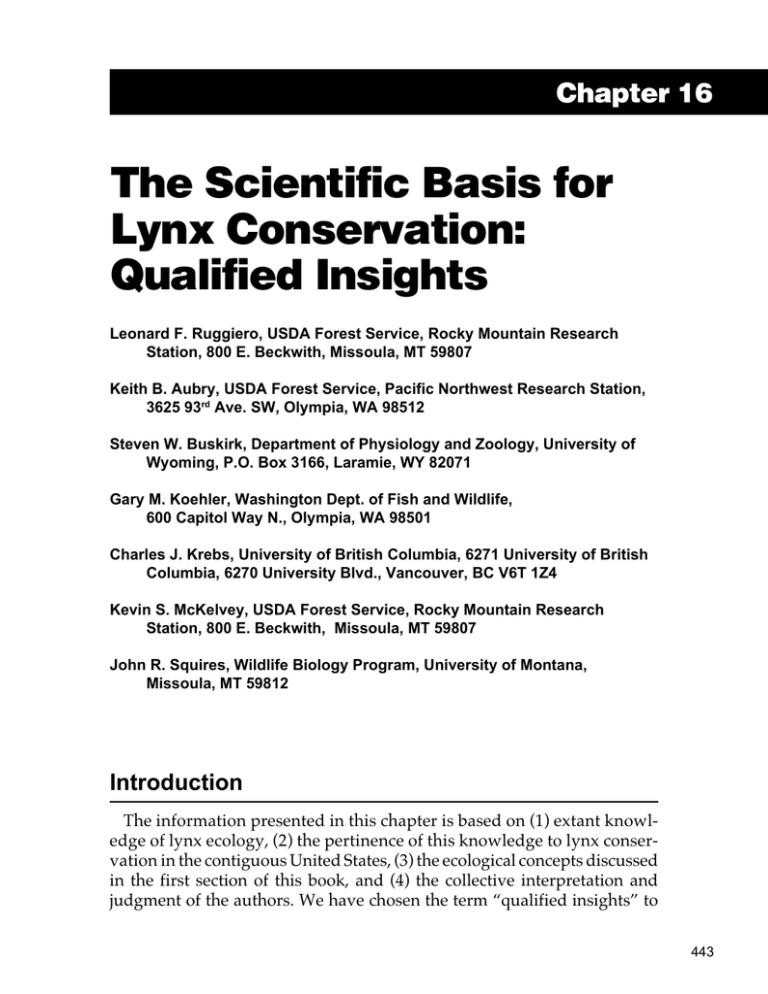
Chapter 16 The Scientific Basis for Lynx Conservation: Qualified Insights Leonard F. Ruggiero, USDA Forest Service, Rocky Mountain Research Station, 800 E. Beckwith, Missoula, MT 59807 Keith B. Aubry, USDA Forest Service, Pacific Northwest Research Station, 3625 93rd Ave. SW, Olympia, WA 98512 Steven W. Buskirk, Department of Physiology and Zoology, University of Wyoming, P.O. Box 3166, Laramie, WY 82071 Gary M. Koehler, Washington Dept. of Fish and Wildlife, 600 Capitol Way N., Olympia, WA 98501 Charles J. Krebs, University of British Columbia, 6271 University of British Columbia, 6270 University Blvd., Vancouver, BC V6T 1Z4 Kevin S. McKelvey, USDA Forest Service, Rocky Mountain Research Station, 800 E. Beckwith, Missoula, MT 59807 John R. Squires, Wildlife Biology Program, University of Montana, Missoula, MT 59812 Introduction The information presented in this chapter is based on (1) extant knowledge of lynx ecology, (2) the pertinence of this knowledge to lynx conservation in the contiguous United States, (3) the ecological concepts discussed in the first section of this book, and (4) the collective interpretation and judgment of the authors. We have chosen the term “qualified insights” to 443 Chapter 16—Ruggiero indicate that we know very little about lynx ecology in the United States and that understandings based on this state of knowledge are necessarily incomplete. The application of science results in a gradual accretion of understanding as relatively small increments of knowledge are added to existing scientific paradigms. This is not to say that the scientific process is always linear, that intuition and creativity are not crucial aspects of the process, or that paradigm-changing flashes of insight do not occur. All of these are elements of the scientific process, but scientific understandings are generally constructed bit by bit as the result of a sustained commitment to research. It follows that scientists generally ask questions that are tractable given the normal tools of scientific investigation, and that large, complex problems are broken down into manageable pieces. As a corollary to this, it is inappropriate to expect scientists to solve complex problems in a single stroke. Yet this is often what ecologists are called upon to do when land managers and decision-makers find that they lack sufficient understanding to meet legal mandates for environmental protection. For example, understanding how the viability of lynx populations is affected by human actions is an extremely complex problem and, because there has not been a sustained commitment to research, the scientific basis for answering this question is inadequate. No amount of socio-political clamoring for reliable answers will change this; uncertainty will prevail. In the following pages, we have attempted to distill the state of knowledge regarding lynx ecology along with our interpretations about the kind and quality of understandings that this knowledge conveys. Because the state of the art is poorly developed for lynx ecology, the first section of this book was devoted to a presentation of salient ecological concepts. These concepts provide a partial basis for the scientific interpretations discussed in Chapter 1. Until additional data are collected, we must assume that insights based on well-established concepts are valid. The eleven topics presented below represent crucial areas of ecological understanding relative to species conservation (Chapter 1). Although we attempted to offer substantive interpretations in each of these areas, a lack of information often prevented us from doing so. We elaborate on these information needs in Chapter 17. 1. Present and Historical Patterns of Lynx Distribution During the 1800s and early 1900s, lynx occurred in Colorado, Idaho, Maine, Michigan, Minnesota, Montana, New Hampshire, New York, Utah, Washington, Wisconsin, and Wyoming. Relatively few records occur in 444 Ruggiero—Chapter 16 other states. Based on an extensive review of historical information, including trapping records, New Hampshire, Minnesota, Montana, and Washington appear to have supported the most lynx. A dramatic decline in lynx numbers appears to have occurred in New Hampshire, where recent records are scarce. Although records from New York, Colorado, and Utah have always been scarce, the lack of recent verified records suggest that lynx may have been extirpated from these states (Chapter 8). The status of lynx in the remaining states is unknown. Extant lynx populations in Washington, Montana, and perhaps Maine occupy habitats that are contiguous with habitats in Canada. It is likely that prior to extensive human development adjacent to the St. Lawrence Seaway, lynx populations in New Hampshire also occurred in habitats that were contiguous with similar habitats in Canada (Litvaitis et al. 1991). In addition, trapping records indicate that lynx populations in Montana, Minnesota, and Washington appear to have cycled in lagged synchrony with lynx populations in Canada during the population highs of the 1960s and 1970s (Chapter 8). The only other known population of lynx is in Wyoming (Chapter 11). This population is thought to be small, is adjacent to extensive park and wilderness areas, and is located within the Greater Yellowstone Ecosystem. We conclude that extensive areas of contiguous suitable habitat are needed to ensure viable lynx populations. All areas in the contiguous United States where we can state with certainty that lynx currently occur are directly connected to larger habitat areas. Apparently, lynx are unlikely to persist in relatively small, isolated refugia of suitable habitat. In saying this, we acknowledge a very incomplete understanding of what constitutes suitable lynx and hare habitat in the contiguous United States. 2. Factors Limiting the Geographic Distribution of Lynx Most lynx records in North America are found in boreal forests (Chapter 8). In the Great Lakes states, most records are in the Mixed Deciduous-Coniferous Province, and, in the northeastern states, most records are in the Mixed Forest-Coniferous Forest-Tundra Province (provinces after Bailey 1998). In the western mountains of the United States, most records are in the Douglas-fir, western spruce/fir, and fir/hemlock vegetation types (Kuchler 1964). All of these types can be characterized as mesic coniferous forests with cold snowy winters. Lynx have morphological adaptations for moving and hunting in snow as exemplified by significantly lower foot loadings than most carnivores (Chapter 4). Records 445 Chapter 16—Ruggiero from Washington, Wyoming, and Utah/Colorado show that lynx occur at higher elevations as one moves south, with modal elevations of 2,000 m, 2,700 m, and 3000 m, respectively (Chapter 8). In addition, it is generally agreed that lynx distributions are limited by the availability of snowshoe hares (Chapter 9). Other than cool, snowy, conifer forests and snowshoe hares, we have not identified additional factors that limit the distribution of lynx. However, this does not mean that additional factors do not exist. Indeed, there are geographic areas that appear to have the necessary features to support lynx, yet lynx occurrence records are scarce or absent from these areas. Three such areas are the Cascade and Coast Ranges in the western United States, the southern Rocky Mountains, and the Great Lake States (except for the extreme northeast corner of Minnesota). Assuming that adequate densities of snowshoe hares exist in these areas, the lack of lynx records indicates that there are factors controlling the distribution of lynx that we do not understand. We conclude that at the broadest geographic scale, lynx distribution is limited to moist, cool boreal forests that support some minimum density of snowshoe hares (e.g., at least 0.5 hares/ha in northwestern Canada but unknown farther south). Lynx are also limited to areas with snowy winters, likely because of their coadaptation with hares and because snow gives lynx a competitive advantage over other carnivores. In the West, lynx are uncommon or absent in coastal forests, possibly due to limiting abiotic factors. 3. Principal Habitat Features Affecting Lynx At the stand level, lynx use a variety of forest types and a broad range of stand ages. Our limited understanding of lynx in the southern part of their range suggests that, as in the North, lynx use habitats with abundant snowshoe hares. However, hare density alone may not be the most crucial factor in lynx hunting success or in habitat selection by lynx. It is unclear how habitat structure affects the vulnerability of hares to capture by lynx. Northern studies suggest that lynx require hare densities of 0.5-1.0 hares/ha to persist, but farther south this relationship may differ. In the North, when hare densities fall below this threshold, lynx expand their home ranges, increase daily travel distances, suffer increased adult mortality, and stop reproducing (Chapter 9). Additional information on this relationship is a critical research need for southern populations. Limited evidence for the southern part of the range suggests that lynx are associated with mesic forest types, and that dry forest types (e.g., 446 Ruggiero—Chapter 16 ponderosa pine) are used mostly to move among mesic stands. These mesic forest types are southern extensions of boreal forests, commonly dominated by spruce and fir, Douglas-fir, and lodgepole pine. In the southern part of the range, these types occur as islands and peninsulas within a matrix of drier, montane forest, typically dominated by lower elevation conifers (Chapter 8). Dense, small-diameter woody vegetation supports high hare densities and, thus, is important for lynx. Such conditions are created by natural disturbances of varying sizes, including gap-phase processes found in lateseral forests (Chapter 14). The successional processes responsible for the creation of the structural features associated with hare habitat are controlled by complex moisture/temperature gradients. Thus, the availability, abundance, and community association of these habitats is spatially variable. However, in the drier portions of lynx range, hare habitat may be increasingly associated with more mesic late-seral forests and riparian areas (Chapter 14). Although areas of regenerating forest created by natural or human-made disturbances can provide important hare habitat, such areas are temporally transient. On the other hand, late-seral forest appears to be moderately productive for hares, very productive for red squirrels, and temporally more stable. The pattern of hare habitat that is optimal for lynx is unknown and represents a critical information need. The negative exponential forest model provides a range of stand ages (Chapter 15) and holds potential as a basis for ensuring persistent populations of hares and lynx. Limited data for southern areas suggest that lynx den in forested sites with relatively large, complex physical structure near the ground, primarily in the form of coarse woody debris. The optimal size and arrangement of such sites is unknown and constitutes another critical information need. We conclude that a snowshoe hare density greater than 0.5 hares/ha is likely required for lynx persistence. Hare habitat occurs in a range of stand ages, including regenerating disturbed stands and late-seral forest. Regenerating stands can be highly productive for hares, but such stands are temporally transient. Late-seral forests tend to be moderately productive for hares but also produce red squirrels and are temporally stable. For lynx to persist, a range of stand ages may be necessary to provide adequate habitat for hares and for denning. However, on drier sites where regeneration is sparse, the value of regenerating stands as hare habitat may be diminished relative to the value of late-seral stands. The negative exponential forest model provides a range of stand ages and thus provides a possible template for landscape management. Our generally poor understanding of lynx-habitat relationships at all spatial scales hampers the development of specific habitat-management prescriptions. 447 Chapter 16—Ruggiero 4. Food Habits of Lynx Snowshoe hares are the primary prey of lynx throughout its range; in studies conducted to date, hares comprised 33-100% of lynx diets. However, when hares are scarce, red squirrels are an important alternative prey (Chapters 9 and 13). In addition to hares and red squirrels, lynx diets include ground squirrels, voles, grouse, ungulates, and carrion. However, a predominance of hares in the diet is believed to be an important determinant of reproduction and recruitment in the taiga, where studies have shown that when lynx diets were composed primarily of species other than hares, productivity approached zero (Chapter 9). Very little is known about lynx diets during snow-free periods, yet foraging ecology during these periods may be an important determinant of habitat use and survival during dispersal and of survival through the critical period of food shortage in the spring. Hence, a more comprehensive understanding of seasonal diets represents an important research need. We conclude that snowshoe hares are the dominant prey of lynx throughout its range, but that red squirrels are an important alternative prey, especially if hares are scarce. However, available evidence suggests that lynx populations are not likely to persist where snowshoe hares do not predominate in the diet. Research is critically needed on lynx food habits in southern boreal forests during both snow and snowfree periods. 5. Habitat Requirements of Key Prey Species Two key prey species for Canada lynx are snowshoe hares and red squirrels. Snowshoe hares are limited to forested landscapes in snowy climates. Hares are closely associated with low, woody vegetation and are most abundant in stands with high densities of small-diameter stems. Hares are most likely to occur in coniferous stands or mixed coniferousdeciduous stands, but in some areas pure stands of deciduous forest are occupied (Scott and Yahner 1989). The critical habitat element for hares is horizontal structure, which serves as both food and cover (Chapter 7). Given the appropriate environmental conditions, this dense vegetation is associated with early seral conditions (e.g., regenerating young stands). This vegetation structure is also associated with late-seral conditions (e.g., in gaps that are part of the natural heterogeneity of old-growth stands - see discussion under item 3 above). Cover for protection from predation is more important than cover as a food source for hares in northern populations (Chapter 6). Reducing dense horizontal structure through silvicultural thinning will likely reduce an area’s carrying capacity for snowshoe hares. 448 Ruggiero—Chapter 16 Red squirrels are closely associated with mature, cone-bearing coniferous forest for food and shelter (Klenner and Krebs 1991; Larsen and Boutin 1995). Densities of pine squirrels, including both red squirrels and the closely related Douglas’ squirrel, tend to be highest in late-successional forests with relatively high amounts of coarse woody debris (Buchanan et al. 1990; Kemp and Keith 1970; Rusch and Reeder 1978). Red squirrels are generally absent in regenerating forests that lack cone production. We conclude that to support abundant snowshoe hare and red squirrel populations, landscapes must contain forested areas with low, dense horizontal structure and late-successional areas with cone-bearing trees and coarse woody debris. The optimal amounts and arrangement of these elements relative to lynx persistence is unknown and represents a critical research need (see Chapter 15 for additional discussion). 6. Population Dynamics of Key Prey Species A key assumption about southern snowshoe hare populations has been that they are relatively stable, in contrast to the dramatic fluctuations seen in northern hare populations (Keith 1990). However, available evidence suggests that southern hare populations may be less stable than previously thought (Chapter 7). Some populations in the Lake States show strong fluctuations over relatively long time intervals, including some evidence of synchrony with northern hare populations. Very limited evidence from hare populations in the western United States is suggestive of fluctuations, but hare populations in the West have been insufficiently studied and their dynamics remain largely unknown. In northern hare populations, predation and food interact to drive changes in numbers (Krebs et al. 1995). The causes of population fluctuations in southern hares are unknown, and we do not know how the fragmentation of hare habitat in the south may influence hare dynamics. Red squirrel populations throughout their geographic range appear to be food-limited, with conifer cone crops driving their population changes. Predation appears to be relatively unimportant to northern red squirrel populations (Stuart-Smith and Boutin 1995), but the impact of predation on southern red squirrel populations is unknown. Red squirrel populations fluctuate but they likely do so independently of snowshoe hare populations. Since red squirrels are important alternative prey when and where hares are scarce, a coincidence of low hare and low squirrel numbers would likely be a significant cause of mortality in foodstressed lynx populations. We conclude that some southern snowshoe hare populations fluctuate strongly and that, in general, southern populations are likely not as stable as previously 449 Chapter 16—Ruggiero thought. Depending on the strength and ubiquity of such fluctuations, southern lynx populations may also be less stable than previously believed. Red squirrel populations fluctuate with conifer cone crops in both the North and the South. The fact that populations of these two key prey species exhibit strong population fluctuations has potentially important implications, i.e., such fluctuations could result in local extirpations of lynx if prey populations bottom-out simultaneously. 7. Principal Community Features Affecting Lynx Various mammals and birds, including coyotes, cougars, bobcats, fishers, great-horned owls, and goshawks may compete with lynx. This competition may reduce available food for lynx and may also result in their displacement or death (Chapter 4). The number of generalist competitors with lynx increases from the northern part of the range to its southern periphery. Moreover, the increased fragmentation of habitats near the southern periphery of the range, and habitat fragmentation in general, may give generalist predators a competitive advantage over lynx. Cougars are locally sympatric with lynx in the western United States during snow-free periods and available evidence suggests they may be an important source of lynx mortality. Coyotes appear to be especially effective competitors with lynx in human-dominated landscapes. Coyotes have expanded their range into the northeastern United States since 1970 and appear to represent an important factor in lynx ecology there. Based on research in the North, humans facilitate coyote access into areas occupied by lynx by compacting snow with snowmobiles, snowshoes, or skis. However, in the southern part of the range few data address competition between coyotes and lynx. We conclude that, in the contiguous United States, competitors, especially the cougar and coyote, likely influence lynx recruitment and survival. Factors that facilitate movement of generalist predators into areas occupied by lynx should be considered a conservation risk. However, data addressing these relationships are very few, and a better understanding of community interactions, and the ways in which landscape pattern may mediate these interactions, is a key research need. 8. Principal Factors Affecting Lynx Movements and Dispersal Knowledge of a species’ movements and dispersal capabilities is critical to the conservation of fragmented, peripheral populations. In northern populations, lynx movements up to 1,000 km have been recorded (Chapter 9), and limited data from southern lynx populations documents movements in 450 Ruggiero—Chapter 16 excess of 100 km (Chapter 13). However, even though long-distance movements may be characteristic of lynx populations, we have no empirical basis for tying such movements to successful dispersal (i.e., establishment of a home range and subsequent reproduction). Understanding the basis for successful lynx dispersal is therefore a key research need with important implications for conservation (Chapters 2 and 8). Lynx readily move across landscapes fragmented by conventional industrial forestry (Chapter 11). Documented lynx movements have involved crossing open valley bottoms and large rivers (Chapter 13); thus, these landscape features are not absolute barriers to dispersal. Although the effect of roads on lynx movements, dispersal, and demographics has not been studied, we have anecdotal accounts of lynx crossing roads of various types. Additionally, we have reliable lynx occurrence records (mostly from trapping) in areas very distant from forested zones (Chapter 8). Assuming these lynx were dispersing from the nearest forested areas, highways were crossed prior to their capture. Although 16 of 83 lynx translocated into New York were killed by vehicles, none of the 89 resident lynx that have been studied with radiotelemetry in southern boreal forests were roadkilled (Chapter 13). Although limited, these observations do not support the hypothesis that roads represent a significant mortality factor for lynx. We conclude that lynx can move long distances, but we do not know if these movements result in successful dispersal or the augmentation of distant populations. Existing data, though sparse, do not indicate that roads are a major mortality factor for lynx. However, the indirect effects of roads on lynx populations, including the effects of urbanization along highway corridors, are unknown. 9. Key Demographic Properties and Dynamics of Lynx Populations Northern lynx populations cycle with hares and dispersal is highest after hare populations start to decline (Chapter 9); we do not know if southern populations behave similarly (Chapter 13). We know little about lynx densities in the southern part of the range, but evidence suggests that they are comparable to those at cyclic lows in the North. In the North, lynx are highly fecund and can double their population size every year under optimal conditions, but the reproductive potential and factors affecting fecundity in southern populations are unknown. Theory suggests that the risk of local extinction increases due to spatially and temporally correlated population fluctuations. Lynx populations in the southern part of the range appear to be small (Chapter 8). Small population size, particularly in combination with population fluctuations, predisposes 451 Chapter 16—Ruggiero these populations to the risk of local extinction (Chapter 2). The probability that such populations will persist depends on many factors, including the degree to which they interact with other populations within a metapopulation structure. However, metapopulation structure per se does little to ensure persistence when colonization rates are low and population sizes are very small. Occupancy of habitat islands in a metapopulation will be governed by rates of colonization and extinction (Chapter 2). For most of the islands to be occupied most of the time, rates of colonization need to greatly exceed rates of local extinction. Dispersal to distant islands from other islands with small populations is unlikely, and even successful dispersal frequently will not result in successful colonization. Population size, distance, and barriers to dispersal between islands are therefore critically important to the stability of the metapopulation. Reductions in population size on the islands simultaneously increases extinction rates and decreases rates of colonization. The removal of habitat islands through land conversion or through large disturbances increases the distance between the remaining islands, and therefore also decreases colonization rates. To maintain a stable metapopulation, it is therefore critically important to maintain or increase the carrying capacity of all areas capable of supporting lynx. We conclude southern lynx habitat must provide for local recruitment and survival. Additionally, southern lynx populations may require immigration from larger contiguous habitat areas. In cases where local populations are relatively small, dispersal rates must be sustained and, in some cases, substantial in order to be effective (from a demographic vs. a genetic standpoint). We know virtually nothing about the vital rates of southern lynx populations, thus assessments of population viability via demographic modeling are not possible. Additional information regarding the influence of prey abundance on lynx population dynamics is critically needed. 10. Geographic Variation Among Lynx Populations All widespread species show some degree of geographic variation among populations. Variation may be primarily inherited or it may be largely based on the responses of individuals to local environments. Regardless of the mechanism, variation among populations can influence fitness and is often adaptive, meaning that populations within species are usually not interchangeable parts (Chapter 5). Knowledge of geographic variation among populations is therefore important for conservation, yet we know little about how much geographic variation exists among lynx populations. Conventional wisdom suggests that highly mobile species may 452 Ruggiero—Chapter 16 show little geographic variation, but we cannot assume this for lynx without data, especially considering the broad range of environments occupied by lynx (Chapter 14). In general, variation among populations has important ramifications for conservation, including identification of distinct population segments, the consequences of translocations, and the degree to which ecological understandings apply from one population to another. We conclude that we know little about geographic variation in lynx, and thus the transfer of either knowledge or animals from northern to southern populations entails significant conservation risks. Moreover, this knowledge gap hampers the identification of potentially distinct population segments for conservation purposes. Understanding the range of genetic, ecological, and behavioral variation among lynx populations is a high research priority. 11. Direct Human Influences on Lynx Direct human influences on lynx include trapping and shooting, vehicle collisions, and behavioral disturbance. Except in Montana, lynx trapping seasons are closed throughout the contiguous United States but lynx may be trapped incidentally or illegally. Evidence from northern areas indicates that when lynx densities are low, human-caused mortality adds to natural mortality (Chapter 9). This means that incidental or illegal killing can significantly affect lynx population dynamics under some circumstances. The effects of recreational activities on lynx populations have not been studied. However, limited anecdotal observations do not support the hypotheses that snowmobiling, ski touring, or hiking result in significant behavioral disturbance to lynx. Winter trails may impact lynx indirectly by providing increased access to competitors, especially coyotes (Chapter 4). It seems likely that disturbance at den sites could increase the vulnerability of kittens to a variety of threats. Lynx exhibit some indifference or curiosity toward humans, which may predispose them to hunting or trapping deaths. Although there is no empirical basis for concluding that roads represent a major mortality source for lynx (Chapter 13), fenced roads and highways or development along transportation corridors may impede lynx movements (Chapter 12). We conclude that there is little empirical information on the direct effects of humans on lynx in southern boreal forests. However, trapping for other large furbearers in areas occupied by lynx may pose a risk. Lynx appear to be extremely susceptible to trapping, and where trapping is permitted it can be (and has been) a significant source of mortality. We cannot extrapolate conclusions about the minimal effects of trapping on northern lynx populations to the historical or potential effects of trapping in southern boreal forests. 453 Chapter 16—Ruggiero Conclusions In this Chapter, we have addressed 11 areas of knowledge that are fundamentally important when planning the management or conservation of any species. In many instances, we were quite tentative in putting forth even “qualified insights” due to a lack of empirical information. When this happened in areas of particular importance, we explicitly included statements of research need as part of our conclusions. In the following chapter we build on these conclusions and present a program of research for closing critical gaps in our knowledge of lynx ecology and natural history. Literature Cited Bailey, R. G. 1998. Ecoregions map of North America; explanatory note. USDA Forest Service, Miscellaneous Publication 1548, Washington, DC. Buchanan, J. B., R. W. Lundquist, and K. B. Aubry. 1990. Winter populations of Douglas’ squirrels in different-aged Douglas-fir forests. Journal of Wildlife Management 54:577-581. Kemp, G. A. and L. B. Keith. 1970. Dynamics and regulation of red squirrel (Tamiasciurus hudsonicus) populations. Ecology 51:763-779. Keith, L. B. 1990. Dynamics of snowshoe hare populations. Pages 119-195 in H. H. Genoways, editor. Current mammalogy. Plenum Press, New York. Klenner, W. and Krebs, C. J. 1991. Red squirrel population dynamics. I. The effect of supplemental food on demography. Journal of Animal Ecology 60:961-978. Krebs, C. J., Boutin, S., Boonstra, R., Sinclair, A. R. E., Smith, J. N. M., Dale, M. R. T., Martin, K., and Turkington, R. 1995. Estimation of snowshoe hare population density from turd transects. Canadian Journal of Zoology 65:565-567. Kuchler, A. W. 1964. Potential natural vegetation of the conterminous United States (map and manual). American Geographical Society Special Publication 36. 116 p. Larsen, K. W. and Boutin, S. 1995. Exploring territory quality in the North American red squirrel through removal experiments. Canadian Journal of Zoology 73:1115-1122. Litvaitis, J. A., Kingman, D., Lanier, J., and Orff, E. 1991. Status of lynx in New Hampshire. Transactions of the Northeast Section of the Wildlife Society 48:70-75 Rusch, D. A. and W. G. Reeder. 1978. Population ecology of Alberta red squirrels. Ecology 59:400-420. Scott, D. P. and Yahner, R. H. 1989. Winter habitat and browse use by snowshoe hares, Lepus americanus, in a marginal habitat in Pennsylvania. Canadian Field-Naturalist 103:560-563. Stuart-Smith, A. K. and Boutin, S. 1995. Predation on red squirrels during a snowshoe hare decline. Canadian Journal of Zoology 73:713-1722. 454

